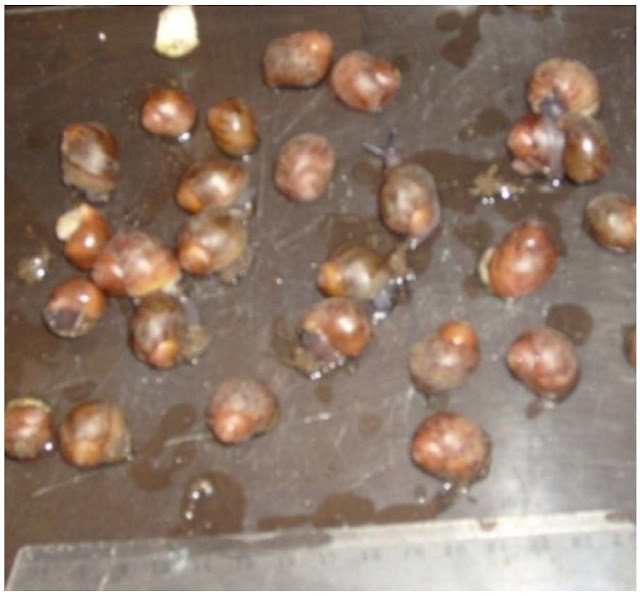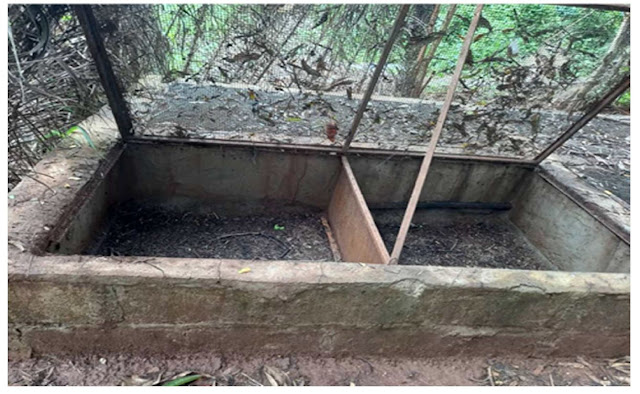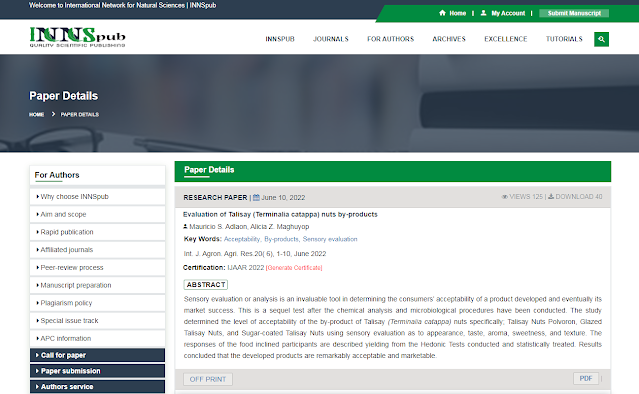Author Information
N’guessan N’guessan Olivier (Université Jean Lorougnon Guédé, Laboratoire de Biodiversité et d’Ecologie Tropicale,Boîte Postale, Daloa, Côte d’Ivoire)
Journal Name
Journal of Biodiversity and Environmental Sciences | JBES
Publisher Name
International Network For Natural Sciences | INNSpub
Abstract
Nine
hundred juveniles of Archachatina marginata aged about two weeks, with an
average live weight of 2.25 g with an average shell length of 20.12mm were
monitored in culture for six (6) months on five types of substrates [S1 (soil
collected in a cassava plantation: Manihot sp.), S2 (S1 with 10% oyster shell
meal), S3 (S1 with 10% sawdust), S4 (S1 with 5% oyster shell meal and 5%
sawdust) and S5 (uncultivated forest soil). Four diets including two industrial
(D1 and D 2 of 12% and 16% calcium respectively) and two based on fodder (D3
and D4 based on leaves and fruit of the papaya (Carica papaya) on the one hand
and a mixture of papaya leaves and taro (Xanthosoma maffafa) on the other hand,
were used. In order to determine the best combinations inducing the best growth
performance, 20 combinations were formed at the rate of 45 spat for each
combination; three replicas of 15 spat each. This study showed that the
combination of diet and livestock substrate influences the growth of Archachatina
marginata. Although the best feed is D1 (74.68 g and 7.94cm) and the best
substrate is S2 (77.12 g and 7.79cm), the best combinations are D2S3 (69.37 g
and 7.47cm), D1S4 (74.68 g and 7.94cm and D4S2 (77.12 g and 7.79cm). The
combined effect of the high level of dietary calcium and that of the culture
substrate does not promote good growth of snails. This work will help improve
the production of African giant snails and provide important data for anyone
wishing to engage in the breeding of these animals.
Introduction
Naturally available food resources play a fairly substantial role in populations (Sodjinou et al., 2002). Among these resources, African giant snails (or Achatines) belonging to the family Achatinidae are found there. These snails are highly valued by many African populations (Zongo 1995). For example, Achatine meat is the most consumed meat in South Benin ahead of aulacode, chicken, sheep or goats, beef and pork (Sodjinou et al., 2002). It is estimated that in Côte d'Ivoire, the population eats 7.9 million kg of snails per year, while in Ghana; demand clearly exceeds production capacity (Cobbinah et al., 2008).
Unfortunately, these protein resources are becoming scarce in their natural environment. To compensate for these deficits, heliculture is one of the alternatives to diversify the sources of animal protein of populations. It is therefore right that initiatives to breed these animals should be carried out in order to satisfy the ever-increasing demand for their consumption, but also to ensure the sustainability of the resource. Thus, several research initiatives on the pace of activity, growth (Ejidike et al., Otchoumou et al., 2004; Kouassi et al., 2016), on reproduction (Otchoumou et al., 2005, Kouassi, 2008) as well as on snail farming substrate were supported (Kouassi et al., 2016; Awohouedji et al., 2017). Indeed, the success of such breeding goes beyond the control of the feed, the breeding substrate, the pathology of these animals, but also and above all by a healthy appreciation of the food according to the different types of breeding substrate.
Thus,
the substrate is a key element for snails as it is both a source of mineral
nutrients and a refuge. In terms of snail production, several studies have
shown the effect of feeding (Kouassi et al., 2007, Kouassi, 2002) or farming
substrate on the growth and reproduction of these animals by a variation in
calcium levels. However, to our knowledge, no studies have yet been devoted to
the combined effect of diet and substrate. The objective of this study is to
highlight the combined effect of diet and culture substrate on the live weight
and growth of the shell of Archachatina marginata in order to optimize its
rearing. It was therefore necessary to evaluate the combined effect of food and
substrate on the weight and shell growth of snails. Check out more by following the link Interaction on the diet and substrate on the growth of Archachatina marginata in breeding
Reference
Awohouedji
DYG, Attakpa EY, Babatounde S, Alkoiret TI, Ategbo JM, Aman JB, Kouassi KD,
Karamoko M, Otchoumou A. 2011. Effet de la teneur en poudre de coquille
d’huître dans le substrat d’élevage sur la croissance d’Archachatina marginata,
Journal of Applied of Biosciences 47, 3205-3213.
Bouye
TR, Ocho-Anin AAL, Memel JD, Otchoumou A. 2017. Effet de l’amendemant au
carbonate de calcium (mikhart) de substrat d’élevage sur les performances de
reproduction de l’escargot Achatina achatina (Linné 1758).
Chevalier
H. 1992. L’élevage des escargots: production et préparation du petit gris,
Edition du point vétérinaire, Paris 144 p.
Cobbinah
JC, Adri V, Ben O. 2008. L’élevage d’escargots : Production, transformation et
commercialisation. Première édition, Wageningen, (Pays-Bas) 84p.
Ebenso
I. E. 2003. Dietary calcium supplements for edible tropical land snails Archachatina
marginata in Niger Delta, Nigeria. Livestock Research for Rural Development 15(5).
Ejidike
BN, Afolayant TA, Alokan JA. 2004. Observations on some climatic variables and
dietary influence on the performance of cultivated African giant land snail (Archachatina
marginata): notes and records. Pakistan journal of Nutrition 3(6), 362-364.
Graham
SM. 1978. Seasonal influences on the nutritional status and iron consumption of
a village people in Ghana. University of Guelph. Canada (Thesis) 180p.
Jess
S, Mark RJ. 1989. The interaction of the diet and substrate on the growth of Helix
aspersa (Müller) var. maxima. Slug Snails Word Agriculture 41, 311-317.
Kouassi
KD, Aman JB, Karamoko M. 2016. Growth performance of Archachatina marginata
bred on the substrate amended with industrial calcium: Mikhart. International
Journal of Science and Research 5(1), 582-586.
Kouassi
KD, Aman JB. 2014. Effet de l’amendement du substrat d’élevage en différentes
sources de calcium sur la croissance de Archachatina marginata. Journal of
Advances in Biology 6(1), 835-842.
Kouassi
KD, Otchoumou A, Dosso H. 2007. Effets de l’alimentation sur les performances
biologiques chez l’escargot géant Africain: Archachatina ventricosa (Gould
1850) En Élevage Hors sol. LRRD 19, 1620.
Kouassi
KD. 2002. Impact de trois espèces d’escargots sur quelques plantes de
l’université d’Abobo-Adjamé: Inventaire et préférence alimentaire. Mémoire de
DEA, UFR-SN, Université d’Abobo-Adjamé/Abidjan – Côte d’Ivoire 48p.
Kouassi
kD. 2008. Effet de l’alimentation et du substrat d’élevage sur les performances
biologiques de Archachatina ventricosa (Gould 1850) et quelques aspects de la
collecte des escargots géants de Côte d’Ivoire. Thèse unique, Université
d’Abobo-Adjamé; n°32, 125p.
Otchoumou
A, Dosso H, Fantodji A. 2003. Elevage comparatif d’escargots juvéniles Achatina
achatina (Linné, 1758); Achatina fulica (Bowdich, 1820) et Archachatina
ventricosa (Gould, 1850): effets de la densité animale sur la croissance,
l’ingestion alimentaire et le taux de mortalité cumulée, Revue Africaine de
Santé et de Production Animale 1(2), 146-151.
Otchoumou
A, Dupont-Nivet M, Dosso H. 2004. Les escargots comestibles de Côte d’Ivoire:
effets de quelques plantes, d’aliments concentrés et de la teneur en calcium
alimentaire sur la croissance d’Archachatina ventricosa (Gould, 1850) en
élevage hors-sol en bâtiment. Tropicultura 22(3), 127-133.
Otchoumou
A, Dupont-Nivet M, N’da K, Dosso H. 2005. L’élevage des escargots comestibles
africain: effet de la qualité du régime et du taux de calcium alimentaire sur
les performances de reproduction d’Achatina fulica (Bowdich, 1820). Livestock
Research for Rural Development. 17(10) www.cipav.org.co/lrrd17/10/otch/17118.htm.
Sodjinou
E, Biaou G, Codjia J-C. 2002. Caractérisation du marché des escargots géants
africains (Achatines) dans les départements de l’Atlantique et du Littoral au
Sud-Bénin. Tropicultura 20(2), 83-88.
Zongo
D, Coulibaly M, Diambara O, Adjire E. 1990. Note sur l’élevage de l’escargot
géant africain Achatina achatina. Nature et Faune 6(2), 32-4.





.jpg)













